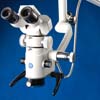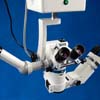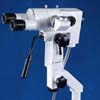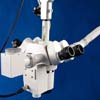Operations On The Orbit
Operations On The Orbit.By F. BULLER, M. D.,
OF MONTREAL,CANADA.
ALL operations on the orbital tissues should be performed in accordance with the strictest principles of antiseptic surgery. Even when septic conditions are present, they will in this way be favorably modified; if absent, the surgeon will himself be to blame if they follow his manipulations. It will not be sufficient to take these precautions merely during the operation. Every time the wound is dressed, and until healing has been fully accomplished, the same vigilance is imperative. The momentary use of an unclean probe may inflict more injury than the disease would have done if left to itself.
Abscess of the Orbit. If an abscess has formed in the orbit, there should be no unnecessary delay in opening it. For this purpose a straight, narrow bistoury may be used, the incision being made at the point of greatest tenderness and swelling, or, if there be fluctuation, where this is most distinct, close to and parallel with the margin of the orbit. There need be no hesitation about thrusting the point deeply into the orbit, but only the external wound should be wide. An opening in the skin and oculo orbital fascia half or three quarters of an inch in length is desirable to relieve tension, unload engorged blood vessels, evacuate pus if present, and facilitate keeping the wound open as long as may be necessary.
This is best done with a tent of borated gauze or lint inserted after thorough cleansing with some warm antiseptic solution, such as a I per cent. solution of pheno salyl or any other that the surgeon may prefer. Compresses of sterilized gauze soaked in warm solution of sublimate 1 : 5000 or boric acid 3 per cent., frequently changed, are to be used till the inflaminatory symptoms subside. The wound itself and the eye must be thoroughly cleansed at least two or three times daily. In severe cases of phlegmonous inflammation of the orbit early and free incision before the formation of pus, both above and below, conducted on the same principles, may be the means of saving the patient's vision or even his life.
Enucleation of the eyeball, eviscerations, and Mules's operation are described on pages 571 573.
Introduction of an Artificial Eye (Prothesis Oculi). An artificial eye should be inserted as soon as the tissues are firmly healed and are able to bear the shell, which is usually from ten days to one month after the operation.
In order to insert an artificial eve the upper lid is seized between the fingers of the left hand and drawn gently down and out, and the larger end of the shell is inserted vertically beneath it, then brought to a horizontal direc¬tion, while at the same time the lower lid is pulled down, when the shell slips into place. In order to remove an artificial eye the bead of a large pin is inserted beneath its lower margin, the lower lid being at the same time depressed, while the eye is tipped upward and forward, when the pressure of the tipper lid will force it out. Very soon patients become exceedingly expert in taking out and introducing artificial eyes, and do not require the aid of a pin in making the manipulation just described.
Until the tissues become accustomed to the artificial eye it should not be worn constantly, and should never be allowed to remain in the socket at night. If the enamel of the shell becomes rough, a new one should be substituted. If the socket or the stum upon which the eye rests becomes irritable p or inflamed, the shell should be removed and the tissues treated with antiseptic lotions and mild astringents until they recover their healthy condition. It should be remembered that badly fitting artificial eyes have occasioned sympathetic inflammation.
Operations for Prothesis in Cases of Cicatricial Orbit. Under certain circumstances, particularly after lime burns and trachoma, contraction of the conjunctival sac and the formation of cicatricial bands may render it impossible for the patient to %vear an artificial eye. A number of operative procedures have been devised to overcome these difficulties, but the results have been confessedly disappointing. Incisions made to admit the shell always close by cicatrization, and, if' anything, increase the contraction. A few successes have followed transplantation of the conjunctiva of a rabbit, the skin of a frog, or Thiersch's graft. Operations based upon the principles of blepharoplasty (page 555) have also been tried.
Harlan's operation.' In a case 'of cicatricial contraction of the cul de sac after enucleation Dr. Harlan proceeded as follows: "A heavy lead wire was inserted beneath the cicatricial bands and passed around the bottom of the cavity, and the ends brought together to form a ring. Way was made for the wire with a pair of fine sharp pointed scissors curved on the flat, and it was inserted behind the lower band, brought out at the outer canthus, reintroduced, and passed in the same way above. The wire was worn for about two months, when it was cut down upon, its track found cicatrized, and the upper sulcus satisfactory. The lower sulcus was deepened by reintroduction of a wire. A thin leaden shell, formed so that its edges would rest where the wire had been, was afterward introduced and left in position constantly, except when the orbit was cleansed with boric acid solution. After the lead shell bad been worn for a few weeks, an artificial eye could be worn without difficulty."
Exenteration of the orbit is performed as follows:
The eyeball, if present, is to be removed in the ordinary way. Then the outer canthus is divided to the orbital margin, the lids drawn strongly upward and downward respectively, and the soft tissues back of them and the periosteum just within the orbital circumference divided with a scalpel. A strong pair of curved scissors is now used to peel off the entire periosteum to the apex of the cavity, where the whole mass is detached by means of a rounded raspatorium guided by the forefinger of the left band. Bleeding from the ophthalmic artery, if considerable, may be checked by pressure with the finger, or by the use of Paquelin's cautery. When bleeding has ceased, the writer applies a thin layer of chlorid of zine paste, spread on lint, to the shreds of tissue left in the spheno maxillary fissure and apex of orbit, packs the cavity lightly with iodoform gauze, and applies a retention bandage. This dressing may be allowed to remain for several days.
If the malignant growth for which exenteration is proposed has involved the skin of the lids, these may require to be removed more or less widely, as well as the orbital structures. The gaping cavity thus produced may at the same operation be greatly diminished by sliding flaps of skin from the neighborhood in such a way as to partly conceal the deformity, or by Thiersch grafts.
Removal of Tumors from the Orbit. The most suitable method of dealing with orbital cysts has already been mentioned (see page 531).
For nevoid or erectile tumors electrolysis gives the best results in young subjects, and way be repeated as often as necessary, every two or three weeks.
The most rapid effect is obtained by introducing two platinum needles, one for each pole. If the growth is large, the needle should be two or three inches in length. The skin is protected by coating the distal half of the needle with collodion. During the operation the needle attached to the positive pole is first introduced to the desired depth and hold in situ. The negative needle is made to penetrate the tissues in several places around this, in each of which it is held in position for two or three minutes. There is some danger of injury to the optic nerve if the needles are passed deeply into the orbit.
General anesthesia is required, and, as reaction may be severe, it is best not to attempt too much during one sitting. In adults these tumors may be partly, or, if encapsulated, completely, excised, and in some cases the electric cautery or thermo cautery may with advantage supplement the knife and scissors.
Osteoid growths springing from or involving the roof of the orbit may be removed, but the operation is somewhat difficult and decidedly dangerous. A large percentage of such cases have died from consecutive intercranial disease abscess or meningitis. Many of these, however, date from preantiseptic days. If the bony growth belongs to the inner or inferior walls, the danger is much less.
The growth must be exposed as freely as possible by suitable incisions of the soft parts covering it, including the periosteum, which must be carefully detached. Then the base of the growth is attacked with hammer and chisel, cutting the bone with tiny rapid strokes until the mass is detached.
The ivory like masses which sometimes project into the orbit from adjacent cavities may be detached and "shelled out" by cutting completely through the normal bone immediately around them: when thus isolated they may be lifted out of the cavity with suitable forceps a procedure which does not require much force in the absence of firm, deep attachments.
Tumors of the orbit which are extensively adherent to the globe or infiltrate the surrounding tissues cannot be removed without sacrificing the eyeball ; for these the operation requires no special description.
In all other cases an attempt may be made to spare the eyeball. In any doubtful case the surgeon should have an understanding that he may sacrifice the eyeball if necessary.
Tumors of the optic nerve may be reached by a vertical wide incision of the conjunctiva over the inner side of the globe, detachment of the internal rectus tendon, which is to be secured and identified by a black silk thread, and held out of the way by an assistant. With the closed blades of curved scissors the tissues are to be separated down to, along, and around the growth quite to the apex of the orbit. With a strabismus hook passed around the nerve at this point as a guide, use the scissors to cut the nerve close to the foramen. Then with small vulsellum forceps bring the growth forward, reversing the globe, and detach close to the sclerotic. Bleeding must be arrested by pressure with the fingers or hot water injections, and the parts irrigated with perchlorid solution 1: 3000 before the tendon and conjunctiva are sutured into place.
Tumors outside the muscle funnel are to be reached by free incision parallel to the orbital margin over the most accessible part of the tumor, doing all the deep dissection, if possible, with the closed scissors blades or handle of the scalpel. Many growths may be successfully "dug out" in this way, with very little loss of blood or injury to the surrounding parts. All bleeding must be arrested before the wound is closed with fine silk sutures, and dressed antiseptically, with suitable provision for drainage.
Kronlein's Operation. Tumors situated far back in the orbit may be exposed to view and removed without sacrificing the eyeball by a method devised by Kronlein, in the following manner: A crescentic incision is made around the outer circumference of the orbit. The periosteum is then divided at this part to a similar extent, and freely detached from the outer wall of the orbit as far as may be necessary. A temporary resection of a wedge shaped portion of the orbital wall can then be made. The base of the wedge corresponds to the outer orbital margin, its apex to the anterior extremity of the inferior orbital fissure. To accomplish this the zygomatic process of the frontal bone is chiselled through, as well as the intervening bone between this and the fissure, near its anterior extremity. In the same way the base of the orbital process of the malar bone is divided, and this second incision through the bone is continued backward to the fissure. The loosened portion of bone, together with the tissues attached to its external surface, may now be drawn toward the temple to such an extent that the orbit is freely exposed at its outer side, and a growth even at the apex is rendered quite accessible, and may be readily removed. After this has been accomplished the triangular flap of bone is replaced, the skin wound united with sutures, and a suitable dressing applied.
It is said that recovery is complete in eight or ten days. The operation is neither difficult nor dangerous, and would seem to merit greater favor and have a wider range of application than it has yet received. It will be found useful in the extirpation of deeply seated orbital tumors, as an exploratory operation in some doubtful cases of exophthalmos, and is an efficient means of relief in violent phlegnionous inflammation of the orbit. Should the exposed orbit be found in such a condition that complete exenteration is deemed advisable, this may be done at the same sitting.
Distention Of the frontal sinus, if recent and of a purulent character, may be relieved by a free opening through its lower external (orbital) wall and subsequent drainage through the same aperture ; but in chronic distention (mucocele), the cavity or cavities having become much wider than in their normal state, simple incision will not suffice. Under these circumstances the surgeon proceeds as follows:
The orbital wall must be so freely removed that the little finger can be passed into the cavity after its thorough evacuation by syringing with some warm antiseptic solution. The little finger of the other hand or a strong probe is to be pushed up the nostril to a point where the finger in the sinus can be felt. Then an aperture of considerable size is to be made with a sharp scoop at this point, and a drainage tube carried through from the orbit and worn until the discharge has ceased or the cavity has sufficiently contracted to justify its removal. Thorough cleansing at least twice daily must be practised for weeks or months to achieve this end.
This operation has the disadvantage of almost certainly injuring the pulley attachment of the superior oblique an accident which may be avoided by making an opening with chisel or trephine in the forehead, a little to one side of the median line, and the counter opening into the nose in the manner just described.
The opening in the forehead may with advantage be sufficiently enlarged to include the entire anterior wall of the sinus; but the disadvantage of this method is the somewhat unsightly resultant sear.
Orbital fistula, if found to extend into the frontal sinus, will heal when the sinus has been dealt with after one or other of the foregoing methods that is, after the sinus has been effectually drained into the nose.
Should the fistula be found to lead into the ethmoidal cells, a free opening may be made down to these parts along the fistulous tract, and any accumulated secretion or other inflammatory debris removed by syringing and the gentle use of small curettes. A drainage tube should then be inserted, and the cavity kept clean by daily syringing until healing takes place. This treatment may be required for several months. Gruening has effected cure of a fistula leading to the ethmoid cells by forcing, with a strong probe, an opening through the base into the nasal cavity, thus facilitating drainage through the nose.
Back to Resources
call toll-free:  or email
or email

 or email
or email
Categories
Categories
Dental
Dental Microscopes
Dental Microscopes
Ophthalmic
Ophthalmic Microscopes
Ophthalmic Microscopes
Gynecology
Gynecology Colposcopes
Gynecology Colposcopes




